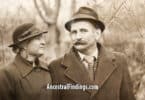If you have French ancestry, some of these French Christmas traditions may be familiar to you. If they are not, learning about them will help you learn more about your French ancestors, such as what their lives and beliefs were like, how they fit into their communities, how their families celebrated, and more. Knowing about these traditions will help you feel closer to them and be a better genealogist. They may also give you some ideas for things to add to your own Christmas celebrations, to give honor to your French heritage.
Pere Noel Postcards
In France, when children write to Santa Clause (referred to there as Pere Noel, which means “Father Christmas”), they will receive a response. Since 1962, the law in France has made sure of it. Any letter sent to Pere Noel must be responded to via postcard, usually from postal workers or volunteers at the postal centers.
Les Calendriers de l’Avent
These are Advent calendars, which were invented in Germany. However, Germany borders France, and France was one of the first countries this beloved tradition made its way to. Now, like children all over the world, the children of France enjoy their Advent calendars.
Le Reveillon de Noel
This is a special Christmas Eve dinner. Everyone stays up late and they do not begin eating until nearly midnight on Christmas Eve. This way, they can be feasting to celebrate the beginning of Christmas Day.
La Creche
La Creche is a nativity scene, and while not every family in France uses one, those who choose to put one up with their Christmas decorations do it up really elaborately. In a true La Creche, it isn’t just the baby Jesus, Mary, Joseph, and the three wise men who are featured. These French nativity scenes are populated by all kinds of characters, including everyone you could imagine might have been present at the birth of Jesus, and even some whose presence is highly improbable.
La Chandeleur
This is the traditional French day when all the nativity displays are taken down. It is considered traditional to keep any nativity scene up until this day. The day is the second of February, which is nearly six weeks after Christmas, which shows you just how much French people love their nativity scenes.
Pere Foettard
A sidekick of Santa Clause (Pere Noel), Pere Fouttard isn’t a character who appears quite so often these days, due to changing sensibilities. However, he was a standard part of Christmas up until about a century ago in France and was the one who punished the “naughty” children while Pere Noel rewarded the “good” ones.
Putting Shoes by the Fire
Putting shoes in various places on or around Christmas is a tradition in several European countries. In France, the tradition is to put them in front of the fireplace (usually with a fire in it) on Christmas Eve, along with snacks and drinks for Pere Noel, with the hope that Pere Noel will fill the shoes with presents. It is a variation on the American tradition of hanging up stockings over the fireplace or the German tradition of putting shoes outside the front door to the house.
The Traditional French Christmas Dinner
Christmas dinner is a big deal in France, and they take the menu seriously. Traditional menu items for a French Christmas dinner include a roast turkey or goose with chestnuts, foie gras, lobster, oysters, venison, and a variety of different kinds of cheeses. Desert usually includes a buche de Noel, which is a chocolate sponge cake log, although in certain areas of France, it is a tradition for thirteen different desserts to be served after Christmas dinner.
In fact, the thirteen desserts tradition is called Les Treize, and it is particular to the Provence area in France. The desserts have symbolic importance, as they represent Christ and his twelve apostles at the Last Supper. A variety of different desserts are served at Les Treize, but common ones that appear on the menu include things like dried fruit, nuts, and different types of cakes. According to Provencal tradition, each person at Christmas dinner must sample each of the thirteen desserts to ensure good luck for the upcoming year.
La Galette des Rois
On January 6, Three Kings Day and Epiphany are celebrated in France. In French tradition, families go to the market and buy a Galette des Rois, which is a holiday-only kind of particular tart. Inside the tart is a porcelain token or figurine called a feve. When the family cuts the tart into slices, whoever gets the slice with the feve in it is proclaimed king or queen for the day in the family. In this role, they get to wear a homemade or store bought crown and choose a king or queen consort for themselves during their “reign.”
Usually, it is the youngest in the family who is supposed to hand out slices of the tart, hiding under the table and calling out the names of the people who are supposed to get each slice (meaning the youngest also chooses who gets each individual slice of tart).
Christmas Alcohol
While you can buy mulled wine at the Christmas markets in France, it is not typically served in French homes during the holiday season. Instead, a high quality wine is a requirement at Christmas dinner, and a variety of champagnes are served at other events during the holidays in France.
Midnight Mass
The midnight mass church service has traditionally been an extremely important part of the Christmas celebrations in France for centuries. It is still practiced, though church services on Christmas Day are becoming more popular in France in modern times.
The Table Decorations
To the French, the appearance of the table on which they will eat their Christmas dinner is extremely important. It has to look both appropriately elegant while still appearing cozy and inviting. Adding three candlesticks to it (which represents the Holy Trinity) is something most French families do. While other table decorations depend largely on personal taste, it is still a big deal to make sure the table is sumptuously decorated. One thing that is an old French tradition going back centuries that most French people still do today is to knot the ends of the tablecloth to prevent Lucifer from getting under the table.
Les Papillotes
Les papillotes are chocolates or candied fruits that are wrapped in sparkling gold, fringed paper. Inside the paper is a tiny note with some kind of inspirational saying, quote, Bible verse, or even joke. Les papillotes were invented at the end of the 1700s, just after the French Revolution, in Lyon, and have become a treasured part of the Christmas celebrations in France since then, and are still used today. Most modern French people use them to decorate their Christmas dinner table, and they are considered an essential part of the Christmas celebrations in modern France.
Mistletoe
Like in other parts of the world, mistletoe is an important and popular part of the Christmas celebrations in France. However, what is strange is that, in a nation known for love and romance, mistletoe is not used as an excuse for kissing in France at Christmas. Instead, it is hung above doorways to bring luck for the upcoming year.
Santons de Noel
The Santons de Noel are little clay figures you can buy to put in your nativity scene. There are always a wide variety of them, and the name translates to “little saints.” After all, anyone who is going to be part of a nativity scene is probably considered a saint of some kind, right? Because there are such a huge variety of Santons de Noel sold at Christmas markets in France, one can make their nativity scene as small or as elaborate as they like, and can even add more santons to it each year, to create an increasing cast of new characters.
Creche Vivante
The crèche Vivante are live nativity shows that are put on during the holidays in France. They are particularly popular in the southwest of France.
La Fete des Rois
Also known as the Part of Kings, this celebration is on Three Kings Day on January 6, and celebrates the arrival of the three magi at the manager after the birth of Jesus. In some areas of France, this is commemorated in the form of a parade or street procession for the children to enjoy.
Les Chants de Noel
Also known as Christmas songs or Christmas carols, these are a relatively new import to France. In the past, the French would merely sing church hymns on Christmas. As Christmas songs became popular in Germany, the United States, and other places, these songs made their way to France with their own French translations. Now, the French enjoy singing the same Christmas carols much of the rest of the western world does.
Traditional Christmas Greetings in France
You have to be very careful what you say to someone as a Christmas greeting in France. Joyeaux Noel or Bonnes Fetes (Merry Christmas or Good Celebrations) are both fine. However, do not say Bonne Annee (Happy New Year) prior to the strike of midnight on New Year’s Day (the moment the day begins), because saying it before then is supposed to bring bad luck… if you live in France.
No Christmas Cards Here
The French do not traditionally send Christmas cards as some other nations do. While a few people may send a handful of isolated Christmas cards here and there in France, it is more traditional to send New Year’s cards instead.
Christkindlsmarik
While Christmas markets are quite popular here, as in other parts of Europe, none are as famous or ancient as the Christkindelsmarik market in Strasbourg in the Alsace region. No one knows quite how old it actually is, but it can be traced with documentation back to at least 1610. It is probably much older than that. People from all across Europe come to enjoy this market, and it includes not only an abundance of Christmas food treats to buy and eat, but also a huge selection of French-made and traditional French gifts to buy for the people on one’s Christmas list. It is a must-attend event for many in France, with people traveling from all areas of the country to make the pilgrimage to it at least once during the Christmas season.
Marche de Noel
While the market in Strasbourg is the oldest, largest, and most popular Christmas market in France, the Christmas market, in general, is a beloved French tradition. These markets are held in other parts of Europe but are particularly popular and beloved in France. You would be hard-pressed to find a town or even a tiny hidden village in France where there is not a market of some kind during the Christmas season. These markets sell gifts and food made by local artisans and farmers. It gives them a chance to showcase their wares and gain new customers for other times of the year besides the holiday season, and gives townspeople and villagers a chance to see and sample new things they might not otherwise encounter. These markets are beloved for their variety of foods and are considered wonderful places to shop for gifts for ones loved ones for the holidays. The holidays would not be complete in France without the Christmas markets.
As you can see, there are a variety of unique and interesting French Christmas traditions both old and new. Some are no longer practiced, but were part of your ancestors’ Christmas celebrations, while others are still practiced today, giving you a real link with the past that your French ancestors lived. Others are new and particular to modern France, which are helpful for learning about the lives of any relatives you have who still live in France. By either practicing some or most of these holiday traditions yourself or simply learning about them, you are becoming a better genealogist and getting closer to your ancient French ancestors and their way of life long ago.






